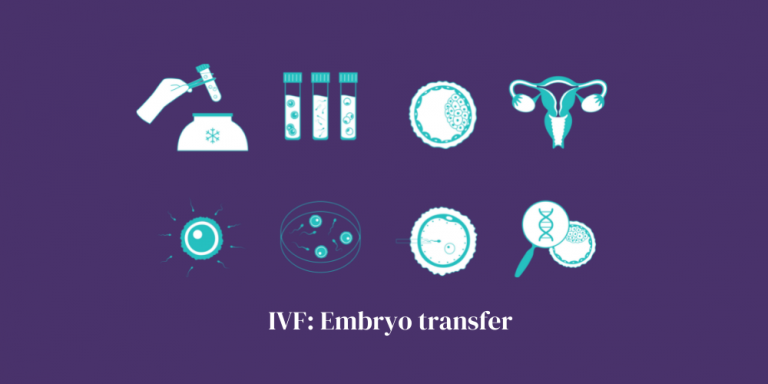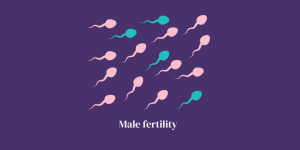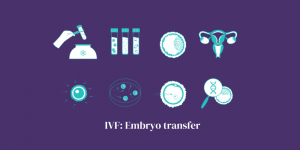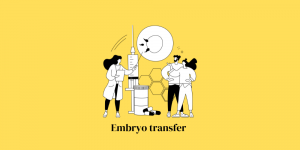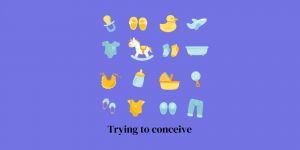Embryo transfer is the last stage of your IVF treatment and takes place following the fertilisation of your eggs by IVF or ICSI. Once the eggs are removed from your ovaries following stimulation with fertility medication, they are fertilised in the lab to form an embryo. The embryo is then transferred to your uterus.
What happens during embryo transfer?
Embryo transfer is a simple procedure which typically takes 5 to 15 minutes and is similar to a cervical screening test. The procedure is usually painless; however, you may experience some discomfort.
To begin with, you will be asked to change into a gown and taken to the procedure room. In the procedure room, your IVF consultant will place a small speculum into your vagina to expose the vaginal walls. A narrow tube, known as a catheter, containing the embryo/s will be gently inserted through the cervix and to the uterus. Once in place, the embryo/s is carefully guided from the catheter into the uterus, along with a small amount of the fluid that the embryo was growing in.
In some cases, the procedure will be carried out using an ultrasound probe which is placed on the lower abdomen to guide the catheter.
You may experience mild cramping, bloating, constipation and/or some vaginal discharge following the procedure.
What is a speculum?
A speculum is an instrument shaped like a duck’s bill. It is used to gently open the walls of the vagina so that the vagina and cervix can be seen or examined more easily.
What is an ultrasound probe?
An ultrasound probe is a small device which uses high frequency sound waves to create “echo” images of parts of your body. Ultrasound is the method used to create “baby scans”.
What is a mock embryo transfer?
A mock embryo transfer is a trial run of the procedure which takes place either before or during your IVF cycle.
A trial run allows the doctor to measure the length from your cervix to your uterus, which varies from woman-to-woman. Knowing this length means the doctor can determine the correct catheter size to use and how it should be placed, as well as the best route and ideal location for embryo transfer.
The trial run also allows the doctor to check for anything that may prevent the procedure from taking place, such as, fibroids or scar tissue or any other problems that may need to be taken into consideration.
What are fibroids?
Fibroids are non-cancerous growths made up of muscular and fibrous tissue which develop in the uterus.
Gynii Me’s Tip: During your first consultation, ask your doctor if it is necessary for you to have a mock embryo transfer. If so, then check whether the mock embryo transfer will take place before your IVF treatment, or before your embryo transfer procedure.
What is the difference between fresh vs frozen embryo transfer?
Embryo transfer can either take place in a fresh transfer cycle or a frozen embryo transfer cycle. In a fresh embryo transfer cycle, your fertility nurse will get in touch with you to let you know the ideal day for your embryo transfer to take place.
The ideal day for embryo transfer will depend on the progress and quality of your embryos. The process for a frozen embryo transfer is similar to a fresh embryo transfer cycle; however, hormone stimulation with medication and collection of eggs is not required. This is because any remaining good quality embryos frozen from previous treatment will be used in a frozen embryo transfer cycle. The frozen embryos will be thawed and only an embryo which has survived the thawing process will be transferred.
Research has shown that frozen embryo transfer success rates are now the same if not higher than fresh embryo transfer success rates. According to the HFEA’s national figures published in May 2019, the overall birth rates per embryo transferred were higher for frozen embryo transfer cycles (23%) compared to fresh embryo transfer cycles (22%).
Read more here:
Gynii Me’s Tip: Most people choose fresh embryo transfer following a fresh treatment cycle. However, sometimes the frozen embryo approach is needed, for example, if OHSS has occurred during IVF treatment.
How does OHSS occur?
To make the eggs grow, fertility drugs, are used to stimulate the ovaries during IVF treatment. Sometimes, this medication causes a reaction, leading to OHSS.
How many embryos should be transferred?
Although the UK law allows for up to two embryos to be transferred in women under the age of 40, it is now common practice to transfer only one embryo and freeze any remaining good quality embryos. This is because single embryo transfer reduces the risk of multiple pregnancies (twins, triplets or more), which can be associated with health risks to both the mother and the babies. This includes an increased chance of early or late miscarriage, premature birth and low birth weight. Research suggests that single embryo transfers are safer and as effective as multiple embryo transfers.
For older women above the age of 40, the law states that up to a maximum of 3 embryos can be transferred. This is because success rates decrease with increasing age, so older women have a reduced chance of successful embryo implantation.
Gynii Me’s Tip: Before the procedure, you and your partner should think about the number of embryos you would like to transfer and discuss this with your doctor to understand the risks and chances of success. The doctor will advise you on the number of embryos to be transferred. However, it is you and your partner who will need to make the decision. You will be asked to sign the consent forms just before the embryo transfer to ensure you accept and have understood the treatment plan.
Day 3 versus day 5 embryo transfer?
The embryo is usually transferred when it is either at day 3 (cleavage stage) or day 5 (blastocyst stage) of embryo growth.
Day 5 embryos usually have a greater chance of implantation success as they develop for longer in the lab. This means there are more good quality embryos to pick from. However, not all embryos will be able to survive until day 5, so there is a risk of being left with no embryos to transfer.
The decision to perform an embryo transfer on day 3 or on day 5 will depend on a number of factors, including ; your age, fertility history, the number of embryos available, and crucially the quality of the embryos. If there are a low number of embryos available to transfer, day 3 embryo transfer will be recommended. This is more common for older women, women with a lower number of healthy eggs and couples with one or two embryos. Younger women with a good number of embryos usually have a day 5 embryo transfer.

